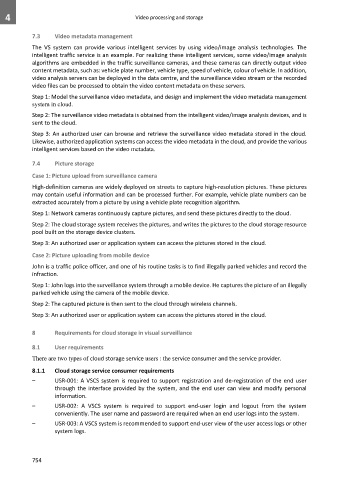Page 762 - Cloud computing: From paradigm to operation
P. 762
4 Video processing and storage
7.3 Video metadata management
The VS system can provide various intelligent services by using video/image analysis technologies. The
intelligent traffic service is an example. For realizing these intelligent services, some video/image analysis
algorithms are embedded in the traffic surveillance cameras, and these cameras can directly output video
content metadata, such as: vehicle plate number, vehicle type, speed of vehicle, colour of vehicle. In addition,
video analysis servers can be deployed in the data centre, and the surveillance video stream or the recorded
video files can be processed to obtain the video content metadata on these servers.
Step 1: Model the surveillance video metadata, and design and implement the video metadata management
system in cloud.
Step 2: The surveillance video metadata is obtained from the intelligent video/image analysis devices, and is
sent to the cloud.
Step 3: An authorized user can browse and retrieve the surveillance video metadata stored in the cloud.
Likewise, authorized application systems can access the video metadata in the cloud, and provide the various
intelligent services based on the video metadata.
7.4 Picture storage
Case 1: Picture upload from surveillance camera
High-definition cameras are widely deployed on streets to capture high-resolution pictures. These pictures
may contain useful information and can be processed further. For example, vehicle plate numbers can be
extracted accurately from a picture by using a vehicle plate recognition algorithm.
Step 1: Network cameras continuously capture pictures, and send these pictures directly to the cloud.
Step 2: The cloud storage system receives the pictures, and writes the pictures to the cloud storage resource
pool built on the storage device clusters.
Step 3: An authorized user or application system can access the pictures stored in the cloud.
Case 2: Picture uploading from mobile device
John is a traffic police officer, and one of his routine tasks is to find illegally parked vehicles and record the
infraction.
Step 1: John logs into the surveillance system through a mobile device. He captures the picture of an illegally
parked vehicle using the camera of the mobile device.
Step 2: The captured picture is then sent to the cloud through wireless channels.
Step 3: An authorized user or application system can access the pictures stored in the cloud.
8 Requirements for cloud storage in visual surveillance
8.1 User requirements
There are two types of cloud storage service users : the service consumer and the service provider.
8.1.1 Cloud storage service consumer requirements
– USR-001: A VSCS system is required to support registration and de-registration of the end user
through the interface provided by the system, and the end user can view and modify personal
information.
– USR-002: A VSCS system is required to support end-user login and logout from the system
conveniently. The user name and password are required when an end user logs into the system.
– USR-003: A VSCS system is recommended to support end-user view of the user access logs or other
system logs.
754

